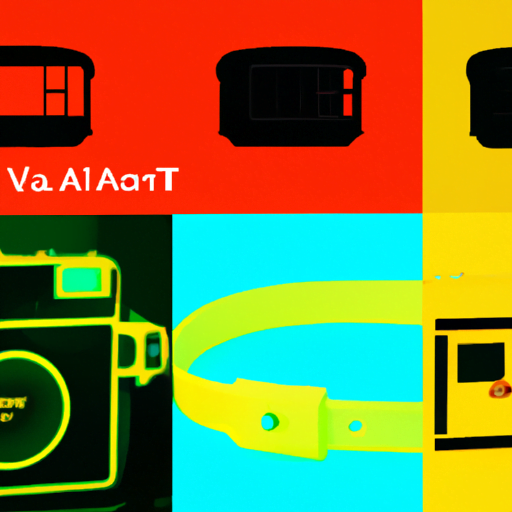
-
Table of Contents
- AI-Infused UX/UI Design for Wearable Technology
- The Importance of UX/UI Design in Wearable Technology
- The Role of AI in Enhancing UX/UI Design for Wearable Technology
- 1. Personalization
- 2. Context Awareness
- 3. Natural Language Processing
- 4. Predictive Analytics
- Case Studies: AI-Infused UX/UI Design in Wearable Technology
- 1. Apple Watch
- 2. Google Glass
- The Future of AI-Infused UX/UI Design in Wearable Technology
- 1. Emotion Recognition
- 2. Gesture Recognition
- 3. Enhanced Health Monitoring
- Summary
AI-Infused UX/UI Design for Wearable Technology

Wearable technology has become increasingly popular in recent years, with devices like smartwatches, fitness trackers, and augmented reality glasses becoming commonplace. These devices offer a range of functionalities, from tracking health and fitness metrics to providing real-time notifications and information. However, the success of wearable technology relies heavily on the user experience (UX) and user interface (UI) design. In this article, we will explore the role of AI-infused UX/UI design in enhancing the usability and functionality of wearable technology.
The Importance of UX/UI Design in Wearable Technology
UX/UI design plays a crucial role in the success of any digital product, and wearable technology is no exception. The design of wearable devices must prioritize user needs and provide a seamless and intuitive experience. Here are some key reasons why UX/UI design is important in the context of wearable technology:
- Usability: Wearable devices are often used in real-time and on-the-go situations. Therefore, the design should prioritize ease of use and ensure that users can quickly and effortlessly interact with the device.
- Aesthetics: Wearable devices are worn on the body and are often visible to others. Therefore, the design should be aesthetically pleasing and align with the user’s personal style and preferences.
- Functionality: Wearable devices offer a wide range of functionalities, from fitness tracking to communication. The design should effectively communicate these functionalities and provide intuitive ways for users to access and utilize them.
- Seamless Integration: Wearable devices often connect with other devices and platforms, such as smartphones and smart home systems. The design should ensure seamless integration with these external systems, allowing users to easily access and control their wearable devices.
The Role of AI in Enhancing UX/UI Design for Wearable Technology
Artificial intelligence (AI) has the potential to revolutionize the UX/UI design of wearable technology. By leveraging AI technologies, designers can create more personalized, intelligent, and context-aware experiences for users. Here are some key ways in which AI can enhance the UX/UI design of wearable technology:
1. Personalization
AI can analyze user data and preferences to create personalized experiences. For example, a fitness tracker can use AI algorithms to analyze a user’s exercise patterns and provide personalized recommendations for workouts and nutrition. This level of personalization enhances the user experience by tailoring the device’s functionalities to individual needs and goals.
2. Context Awareness
AI can enable wearable devices to understand and adapt to the user’s context. For example, a smartwatch equipped with AI capabilities can automatically adjust its display brightness based on the ambient lighting conditions. This context-awareness improves usability and ensures that the device adapts to the user’s environment in real-time.
3. Natural Language Processing
AI-powered natural language processing (NLP) can enable voice commands and voice recognition in wearable devices. This allows users to interact with their devices using natural language, making the experience more intuitive and hands-free. For example, a smart glasses device equipped with NLP capabilities can respond to voice commands for navigation or information retrieval.
4. Predictive Analytics
AI can leverage predictive analytics to anticipate user needs and provide proactive recommendations. For example, a smartwatch equipped with AI algorithms can analyze a user’s calendar and location data to provide timely reminders and suggestions. This predictive capability enhances the user experience by anticipating user needs and reducing the cognitive load of managing multiple tasks.
Case Studies: AI-Infused UX/UI Design in Wearable Technology
Several companies have already embraced AI-infused UX/UI design in their wearable technology products. Let’s explore a few case studies that highlight the impact of AI on the user experience:
1. Apple Watch
The Apple Watch is a prime example of AI-infused UX/UI design in wearable technology. The watch uses AI algorithms to analyze health and fitness data, providing personalized activity goals and coaching. It also incorporates context-aware features, such as automatically detecting when the user starts a workout and reminding them to stand up if they have been sitting for too long. These AI-powered features enhance the usability and functionality of the device.
2. Google Glass
Google Glass, an augmented reality wearable device, utilizes AI to enhance the user experience. The device incorporates natural language processing, allowing users to interact with the device using voice commands. It also leverages AI algorithms to provide real-time information and notifications based on the user’s context, such as weather updates and navigation directions. These AI-powered features make the device more intuitive and user-friendly.
The Future of AI-Infused UX/UI Design in Wearable Technology
The integration of AI into UX/UI design for wearable technology is still in its early stages, but the potential for innovation and improvement is immense. As AI technologies continue to advance, we can expect to see further enhancements in the user experience of wearable devices. Here are some potential future developments:
1. Emotion Recognition
AI algorithms can be trained to recognize and respond to users’ emotions. This could enable wearable devices to provide personalized recommendations and support based on the user’s emotional state. For example, a smartwatch could detect signs of stress and offer guided breathing exercises or relaxation techniques.
2. Gesture Recognition
AI-powered gesture recognition could enable users to interact with wearable devices through hand movements and gestures. This would provide a more natural and intuitive way of controlling and navigating the device. For example, a smart ring equipped with gesture recognition could allow users to answer calls or control music playback with simple hand movements.
3. Enhanced Health Monitoring
AI can play a significant role in improving health monitoring capabilities in wearable devices. By analyzing data from various sensors, AI algorithms can detect patterns and anomalies that may indicate health issues. This could enable early detection of conditions such as irregular heart rhythms or sleep disorders, providing users with valuable insights and potentially life-saving information.
Summary
AI-infused UX/UI design has the potential to revolutionize the usability and functionality of wearable technology. By leveraging AI technologies, designers can create personalized, context-aware, and intuitive experiences for users. The integration of AI into wearable devices enhances usability, enables natural language interaction, and provides predictive capabilities. Companies like Apple and Google have already embraced AI in their wearable products, showcasing the impact of AI on the user experience. As AI continues to advance, we can expect further developments in emotion recognition, gesture recognition, and health monitoring in wearable technology. The future of AI-infused UX/UI design in wearable technology is promising, and it holds the potential to transform the way we interact with and benefit from wearable devices.
